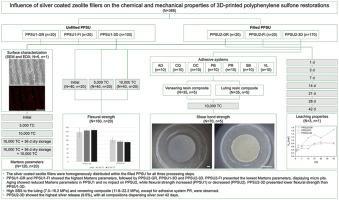银涂层沸石填料对 3D 打印聚苯砜修复体化学和机械性能的影响。
IF 3.3
2区 医学
Q2 ENGINEERING, BIOMEDICAL
Journal of the Mechanical Behavior of Biomedical Materials
Pub Date : 2024-09-26
DOI:10.1016/j.jmbbm.2024.106756
引用次数: 0
摘要
目的:研究聚苯砜(PPSU)的化学和机械性能取决于其成分和制造工艺:研究聚苯砜(PPSU)的化学和机械性能取决于其成分和制造方法:方法:将未填充的聚苯硫醚 1 和填充了抗菌银涂层沸石的聚苯硫醚 2 制成颗粒状-GR、丝状-FI 或印刷型-3D 试样。对试样进行了扫描显微镜和 X 射线光谱分析。测定了初始和老化后的马顿硬度-HM、弹性压入模量-EIT 和抗弯强度-FS。用 7 种粘合剂系统调节后,老化后检测了与贴面和胶合复合材料的剪切粘接强度-SBS。在 1 天、3 天、7 天、14 天、21 天、28 天和 42 天后对银浸出进行了测试。计算了方差分析、Kolmogorov-Smirnov、Kruskal-Wallis、Mann-Whitney U、非配对 t 检验和 Weibull 模量(p 结果:沸石呈均匀分布。PPSU1-GR 和 PPSU1-FI 显示出最高的 HM/EIT,其次是 PPSU2-GR、PPSU1-3D 和 PPSU2-3D。PPSU2-FI 的 HM/EIT 最低,显示出微凹坑。老化显示 PPSU1 的 HM/EIT 减少,对 PPSU2 没有影响,而 FS 则增加(PPSU1)或减少(PPSU2)。PPSU2-3D 的 FS 低于 PPSU1-3D。除粘合剂系统 PR 外,敷贴(7.0-16.2 兆帕)和贴面复合材料(11.8-22.2 兆帕)的 SBS 都很高。PPSU2-3D 显示出最高的银释放率(9.6%),所有成分都在 42 天内释放出银:结论:在 6 周的考察期内,填充的 PPSU 释放出了抗菌银离子。PPSU 与贴面/粘接复合材料之间的高 SBS 证实了对填充 PPSU 进行美学贴面和粘接的可行性。为了获得与未填充聚苯硫醚相同的机械性能,需要对填充聚苯硫醚的加工参数进行改进:这项研究证明了聚苯硫醚可以成功掺入银涂层沸石。三维打印与抗菌热塑性塑料的结合为修复牙科领域带来了巨大机遇。潜在的应用领域包括活动义齿扣、临时或永久固定义齿扣和种植基台。本文章由计算机程序翻译,如有差异,请以英文原文为准。

Influence of silver coated zeolite fillers on the chemical and mechanical properties of 3D-printed polyphenylene sulfone restorations
Objectives
To investigate the chemical and mechanical properties of polyphenylene sulfone (PPSU) depending on its composition and manufacturing.
Methods
Unfilled–PPSU1 and with antimicrobial silver coated zeolites filled–PPSU2 specimens were made of granulate–GR, filament–FI, or printed–3D. Scanning microscopy and X-ray spectroscopy were performed. Martens hardness–HM, elastic indentation modulus–EIT and flexural strength–FS were determined initially and after aging. Shear bond strength–SBS to veneering and luting composite after conditioning with 7 adhesive systems were examined after aging. Silver leaching was tested after 1-, 3-, 7-, 14-, 21-, 28- and 42 days. Analyses of variance, Kolmogorov–Smirnov, Kruskal–Wallis, Mann–Whitney U, unpaired t-tests and Weibull modulus were computed (p < 0.05).
Results
Zeolites were homogeneously distributed. PPSU1-GR and PPSU1-FI showed the highest HM/EIT, followed by PPSU2-GR, PPSU1-3D and PPSU2-3D. PPSU2-FI presented the lowest HM/EIT, displaying micro pits. Aging showed reduced HM/EIT in PPSU1 and no impact on PPSU2, while FS increased (PPSU1) or decreased (PPSU2). PPSU2-3D presented lower FS than PPSU1-3D. High SBS to the luting (7.0–16.2 MPa) and veneering composite (11.8–22.2 MPa), except for adhesive system PR, were observed. PPSU2-3D showed the highest silver release (9.6%), with all compositions dispensing silver over 42 days.
Conclusions
For the examined period of 6 weeks, antimicrobial silver ions were released from filled PPSU. The high SBS between PPSU and veneering/luting composite confirmed the feasibility of esthetically veneering and luting filled PPSU. To achieve mechanical properties like unfilled PPSU, the processing parameters of filled PPSU require refinement.
Clinical significance
This investigation provides proof of principle that PPSU can be successfully doped with silver-coated zeolites. The combination of 3D-printing with an antimicrobial thermoplastic constitutes a great opportunity in the field of prosthetic dentistry. Potential applications include clasps for removable dental prostheses, provisional or permanent fixed dental prostheses and implant abutments.
求助全文
通过发布文献求助,成功后即可免费获取论文全文。
去求助
来源期刊

Journal of the Mechanical Behavior of Biomedical Materials
工程技术-材料科学:生物材料
CiteScore
7.20
自引率
7.70%
发文量
505
审稿时长
46 days
期刊介绍:
The Journal of the Mechanical Behavior of Biomedical Materials is concerned with the mechanical deformation, damage and failure under applied forces, of biological material (at the tissue, cellular and molecular levels) and of biomaterials, i.e. those materials which are designed to mimic or replace biological materials.
The primary focus of the journal is the synthesis of materials science, biology, and medical and dental science. Reports of fundamental scientific investigations are welcome, as are articles concerned with the practical application of materials in medical devices. Both experimental and theoretical work is of interest; theoretical papers will normally include comparison of predictions with experimental data, though we recognize that this may not always be appropriate. The journal also publishes technical notes concerned with emerging experimental or theoretical techniques, letters to the editor and, by invitation, review articles and papers describing existing techniques for the benefit of an interdisciplinary readership.
 求助内容:
求助内容: 应助结果提醒方式:
应助结果提醒方式:


